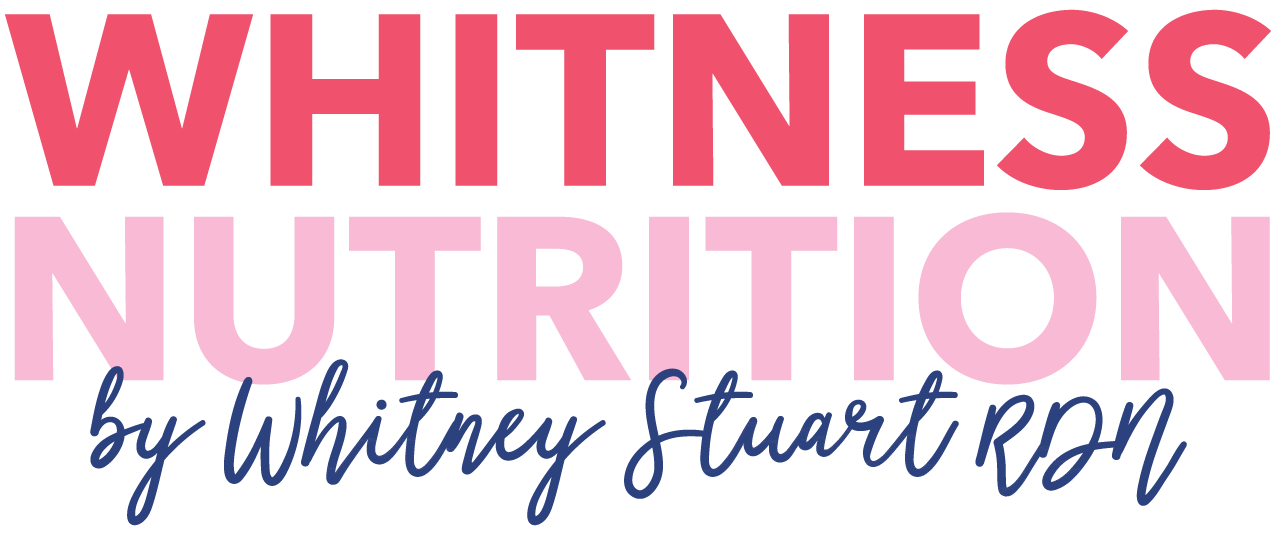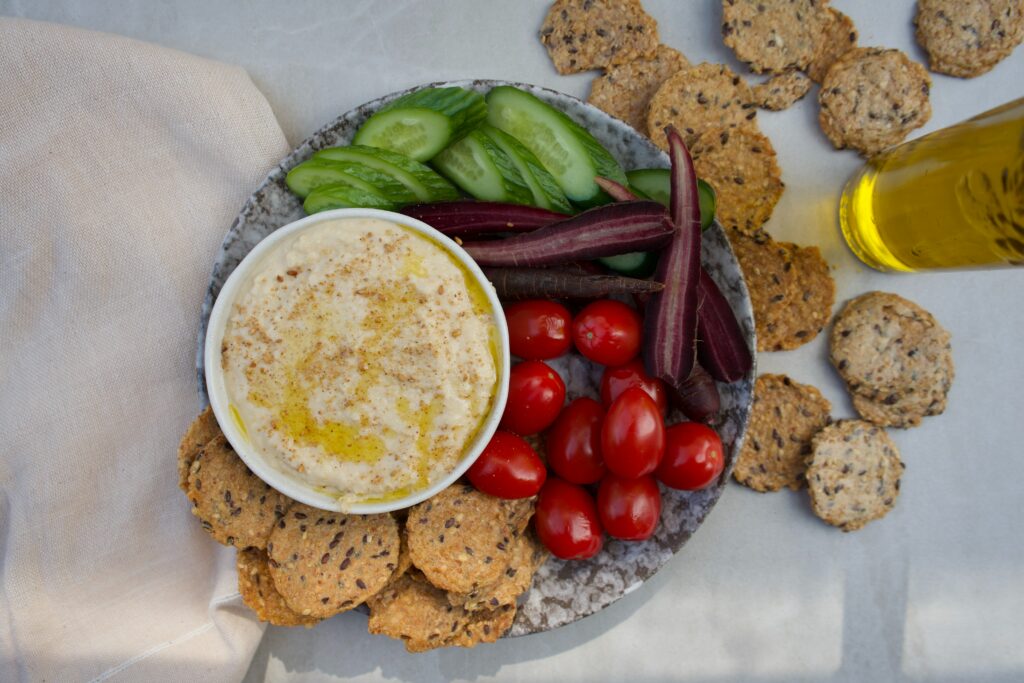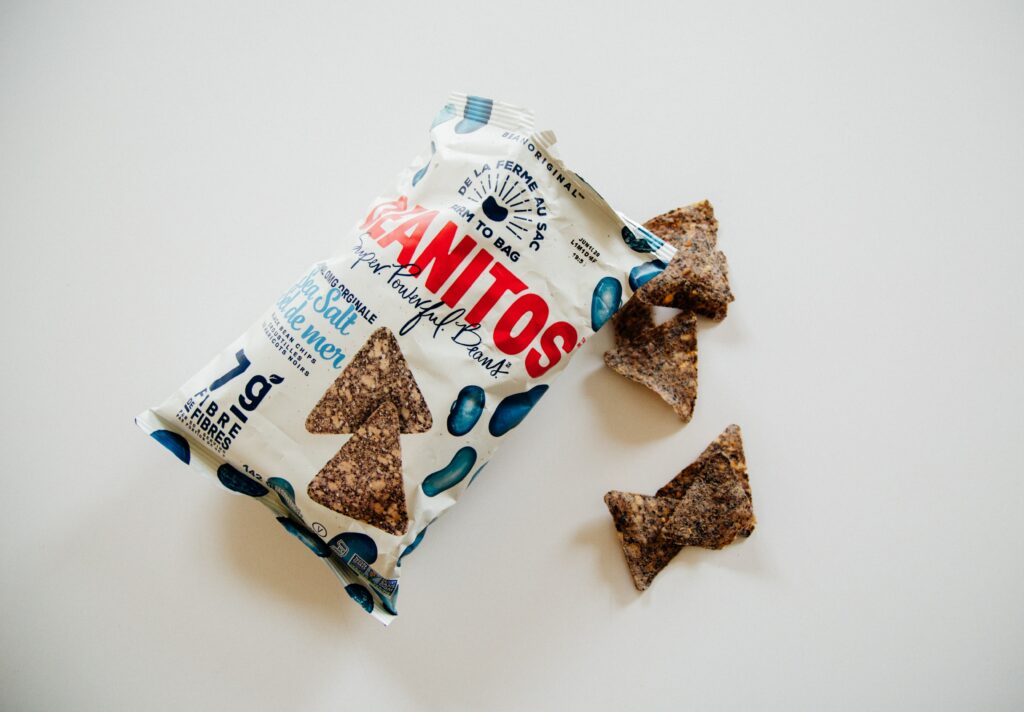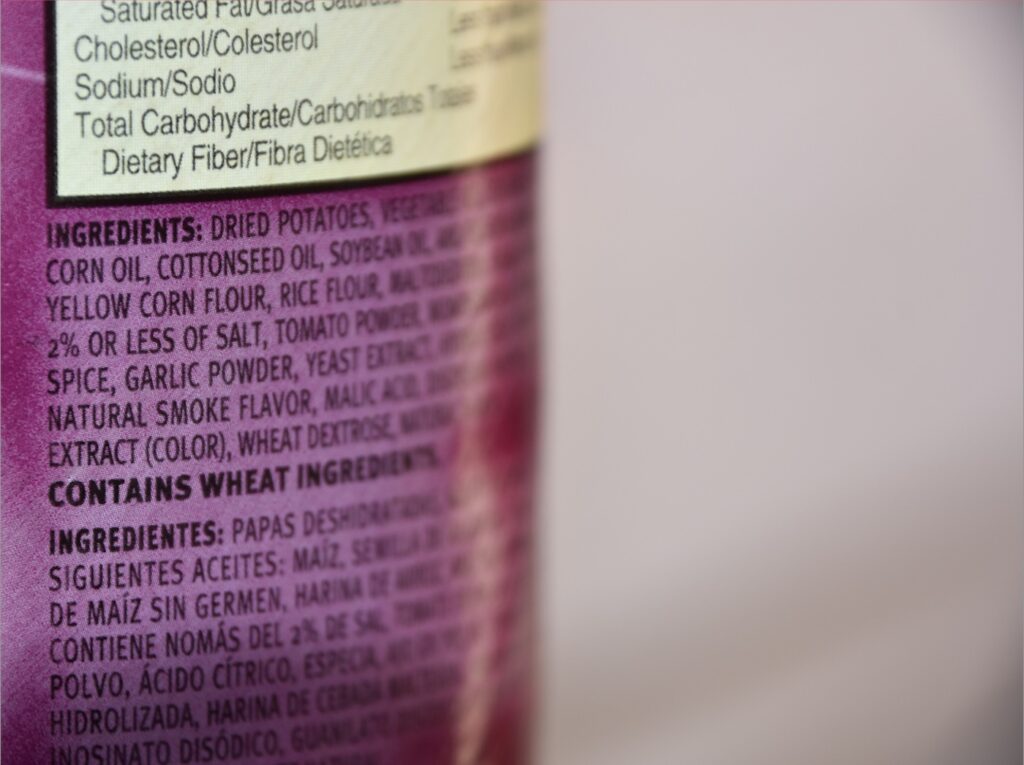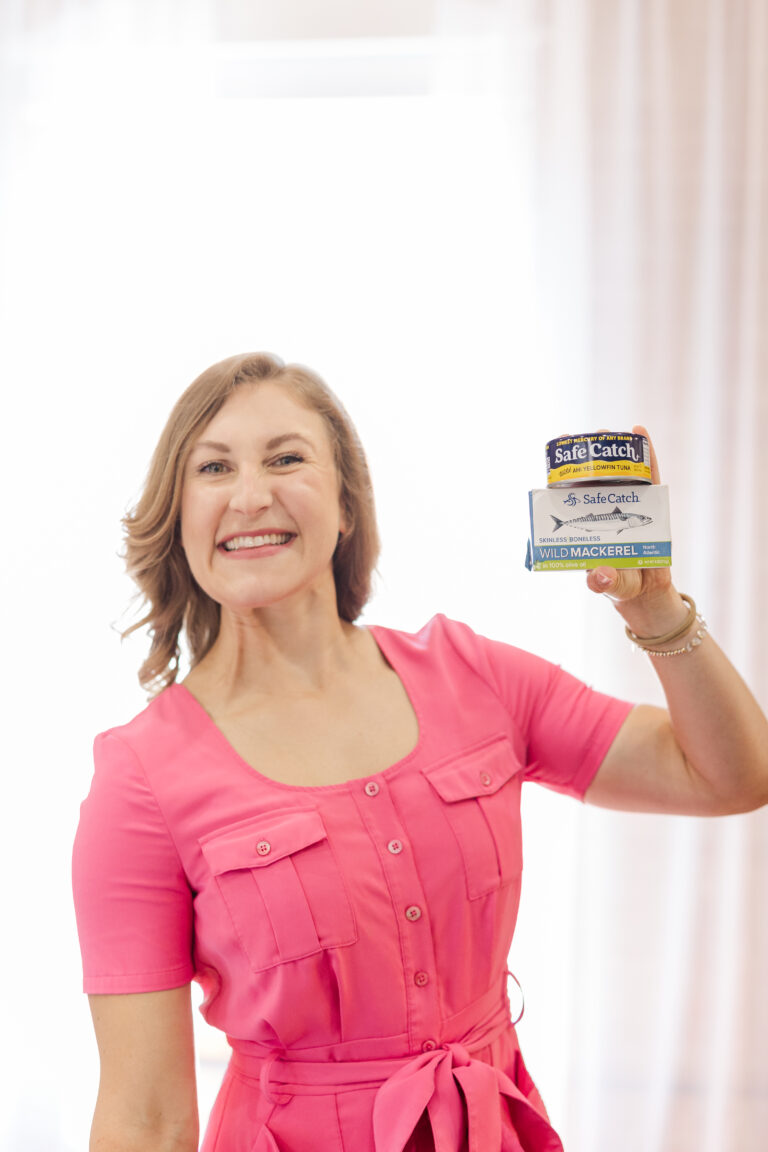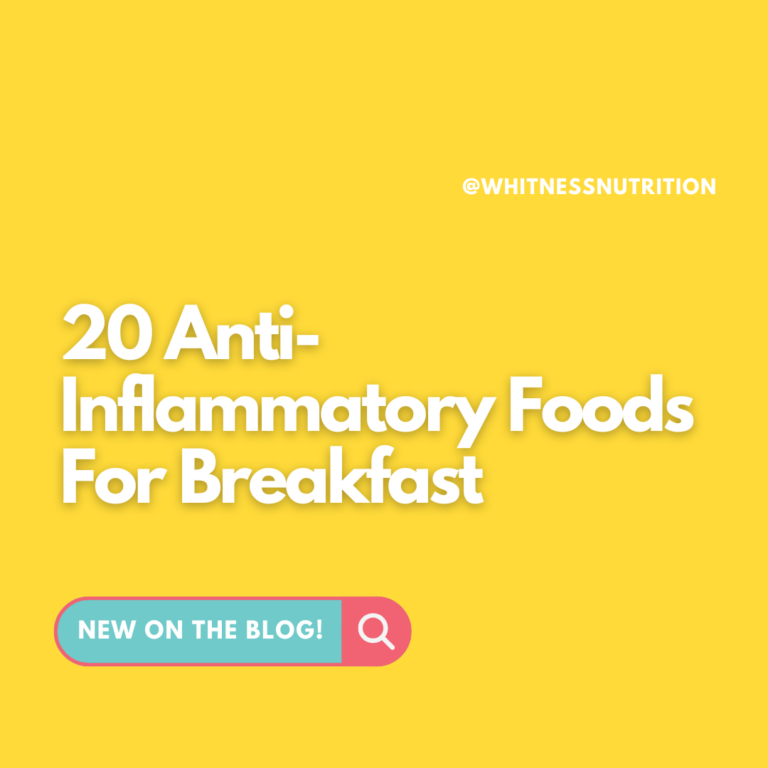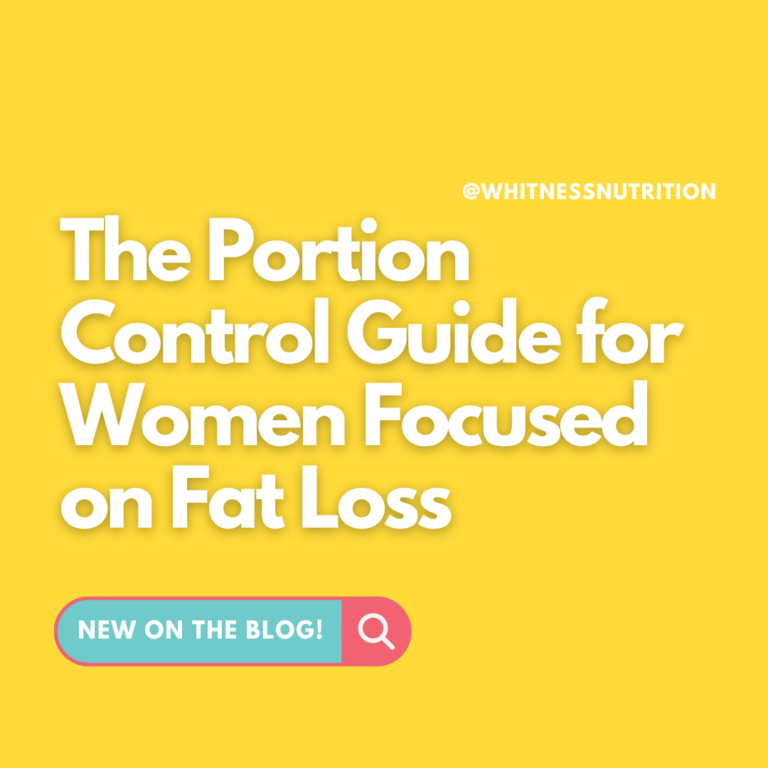The Best Diabetes-Friendly Packaged Snacks
If you are someone who has diabetes or perhaps knows someone with diabetes, it is likely you have wondered “what counts as a diabetes-friendly snack?” Whether it’s pretzels and popcorn, or apples and oranges, diabetes-friendly snacks are something that a decent amount of thought. As a Registered Dietitian and Diabetes educator who has been working with the diabetic population for over 10 years, I know that this is something many struggle with. Whether you’re a mom, someone constantly on the go or someone looking to better their dietary habits, it’s good to have diabetes-friendly packaged snacks on hand. And trust me, it’s a great question to ask and consider! As we know, snacks are an essential part of a well-rounded, blood sugar balanced diet.
The Best Diabetes-Friendly Packaged Snacks
As you may imagine, receiving a diabetes diagnosis, it can feel like most food is now off limits! But, there are some incredible diabetes-friendly packaged snack options on the market that can be a part of a balanced and healthy diabetes diet. I’ve created a list of great packaged snack options for you to utilize that meet all the criteria I look for, as a dietitian and diabetes educator. Balanced snacks can sustain energy levels and stabilize blood sugar levels. That snack is going to keep you fueled in between meals and feeling your best.
But first, you may be wondering…
What foods can diabetics eat freely?
A diet that contains a variety of high-quality protein, healthy fats, legumes and non-starchy vegetables is ideal for someone with diabetes. You’ll notice I said non-starchy vegetables are ideal, not all veggies. Starchy veggies, such as white potatoes or corn, are higher in sugar. If a patient with diabetes were to come to me and ask “what foods should always go on my grocery list?” I would likely tell them to start with something like this:
- Protein: cage-free eggs, canned tuna/salmon, chicken, greek yogurt and turkey.
- Healthy Fats: nuts, seeds, olives, avocado oil or olive oil based dips and spreads.
- Non-starchy veggies: celery, cucumbers, zucchini, bell peppers and cauliflower.
- Fiber: legumes and low-glycemic fruit such as berries or pears.
If you are looking for a more indepth look at what foods diabetics can eat freely, schedule a call and request for a grocery tour!
What should I look for on the label of a diabetes-friendly packaged snack?
I love a balanced snack for diabetes management! This means, a snack should contain protein, and/or fat, minimal to no added sugar, and have less carbohydrate than protein or fat. The amount of carbohydrate in your snack is going to determine how much it affects your blood sugar. We want to minimize these lonely carbs, as much as possible. Lonely carbs lead to blood sugar spikes and worsen glycemic control (a higher A1C and potentially, more insulin usage).
A few protein-focused snacks include:
- Greek yogurt with nuts and berries
- Hard-boiled eggs with avocado and baby carrots
- Cottage cheese with tomatoes and cucumbers
But, let’s be realistic here. How many of us have time for a beautifully balanced bowl of greek yogurt with chopped nuts and fresh berries? It’s not often! That’s why proper education around picking healthy packaged snacks is important for everyone, especially those with diabetes. Whether it’s because you’re constantly on the go or are just looking for a change, properly picking a snack choices is important.
And please note! Those with both Type 1 diabetes, Type 2 diabetes, LADA and Gestational diabetes benefit from these smarter snack habits. Despite the type of onset, balanced blood sugar, reduced insulin resistance and reduced insulin/medication usage is a common goal which can improve by educated food choices and better packaged snacks!
To help you make the right choice when choosing packaged snacks, I’ve rounded up the best packaged snacks for diabetes and those looking to achieve blood sugar bliss.
What Makes a Healthy Packaged Snack?
And, what do I look for in a snack to ensure it’s good for my blood sugar? Although there are so many healthy options on the market, it can feel overwhelming to know which one is right for you! Use these parameters when selecting a snack next time you’re at the grocery store. Or, reach out to work together and we can complete a Pantry Audit 1:1 appointment together!
1.Anti-Inflammatory Ingredients
Real, whole food based ingredients should always come first. What I mean by “whole food” is foods that contain minimal additives and preservatives. Think nuts, seeds, vegetables, and legumes. Almond flour crackers are a good example. While they are a cracker, which is traditionally a higher carb food, almond flour crackers are made from a real-food base of nuts that contain healthy fats and protein. We also want to avoid ingredients that are known to cause harm to our body like nitrates, inflammatory oils and artificial ingredients like food dye.
2. Well-Balanced Macronutrients
Fiber: three things to consider, the amount, the source, and insulin dosing for fiber
- First: I recommend getting at least 5-10 g of fiber per snack. Look for at least 15% on the nutrition label. We need adequate fiber intake to help maintain blood sugar by slowing down digestion and absorption of nutrients, which includes glucose.
- Second, while you’ll often see really large amounts of fiber (>50%) from filler like inulin and tapioca fiber, more isn’t always better. I like natural sources of fiber like flaxseeds, chia seeds or vegetable pulp but when levels of fiber get about 35% people tend to have bloating and belly distention from too much too quickly.
Note: if you are determining insulin dosage off of the amount of carbohydrate in your food, you need to consider the amount of fiber present. Fiber doesn’t have a prominent effect on blood sugar, thus it needs to be removed from the equation. I ask patients to subtract 50% of the fiber (in a food that is actually rich in it) when dosing for insulin. Consider that a protein bar with 15g of carbohydrate but 10g of fiber would only count for (15-(10/2)) 10g of active carbohydrate. This is how you easily determine a safe amount of insulin to take and also how to determine net carbs.
3. Healthy Fats:
We want to see heart healthy sources of fats like nuts or nut butter, avocado oil or seeds. Avoid trans fats when possible such as shortening or palm oil.
4. Protein:
Aim for at least 10-15g of protein per snack, but ideally closer to 20g. This is something you’ll need to be extra cautious for in many packaged snacks, as this is where tricky terms and labels will get you! If you’re munching on something like a protein bar, always compare the net carb and protein grams on the label. If the protein content is higher than the net carbohydrates (total carb – total fiber), you’ve got a great blood-sugar balanced snack!
5. Low Sugar, Low-Glycemic
When it comes to packaged snacks, look for low-glycemic, naturally-sourced sweeteners. A few examples of low-glycemic sweeteners include:
-
- Honey or maple syrup
- Stevia or allulose
- Monk fruit or coconut sugar
Added sugar: Overall, the AHA, The American Heart Association, recommends one should limit added sugars to no more than 6 percent of calories each day. For most American women, that’s no more than 100 calories per day, or about 6 teaspoons of sugar. It’s important to note that ALL carbohydrates spike blood sugar, not just added sugar. When you consider the sugar content of your packaged snacks, make sure to evaluate the total carbohydrate count.
If you only consider the sugar content, you’re missing the whole picture and it may lead to a large blood sugar spike. Examples: bananas are 100% carbohydrate but they have no added sugar, likewise for oatmeal, rice and quinoa. These foods largely spike blood sugar without pairing them with a fat or protein, even though they have no added sugar.
How to Choose the Best Diabetes-Friendly Packaged Snacks for Blood Sugar Balance
1. Read The Label:
One of the first things I discuss with patients is how to properly read a label. Learning how to read a label will not only help you make healthier choices, but can directly improve your blood sugar, decrease the time you spend at the store, and reduce the intake of inflammatory foods that contain excessive added sugar, low fiber and trans fats. When it comes to snacks, always ask – what category does this food fall into? Is this going to spike my blood sugar?
Overwhelmed at the grocery store? Learn to read a label using my Label Reading E-Book!
2. Order of Ingredients:
Ingredients are listed in order of their prevalence in the recipe. Meaning, whatever is at the front of the list of ingredients is what will is present in higher amounts. As you can imagine, the shorter the list the better, especially if it’s simple & straightforward ingredients. When you choose a pre-packaged snack, aim for the ingredients list to start with whole food sources such as nuts, seeds, vegetables, fruits and whole grains. If you notice your snack starts with some form of sugar, such as brown rice syrup or fruit juice, you have collateral to put that snack back on the shelf and deem it a lonely carb.
Generally, the ingredients to try and steer clear of include:
- Vegetable oils; canola, safflower, sunflower, soybean, peanut or palm oil
- Sugar alcohols such as sucralose or maltitol. These are both known to contribute to gut dysfunction and cause bloating, constipation and diarrhea.
- Artificial sweeteners such as aspartame and saccharin. These are 100x sweeter than cane sugar and can actually drive your sweet cravings!
Especially important when it comes to finding diabetes-friendly packaged snacks, is keeping a careful eye out for added sugars.
3. Added Sugars
When most people hear the word “diabetes” they immediately think of sugar. And they are right to do so! Sugar has a direct effect on our blood sugar, and those with diabetes must monitor their blood sugar carefully. Just a reminder, added sugars include any sugars or sweeteners that are added to foods or beverages during processing. So, even though agave syrup may seem “healthier” than cane sugar, it is still an added sugar and should be avoided in excess amounts. Labels to look for:
- Sugar-Free: A sugar-free product contains less than 0.5 g of sugar per serving. Sugar free products are typically made with sweetener alternatives like monk fruit or maltitol.
- No sugar added: no ingredients containing sugar were added during the manufacturing process. But, this does not mean it’s free of any sugar. For example, dried mango may say no added sugar on the label, it still can have upward of 25g of naturally occurring sugars per serving.
Aim to keep added sugars to a minimum of 5g in your packaged snacks. If the added sugar source is a lower-glycemic option like honey or maple syrup, that’s even better.
Reducing sugar intake and balancing your blood sugar is a big part of my Diabetes Mastery Course, a self-paced, 100% online course that teaches you the 101 on how to achieve #bloodsugarbliss. Interested? Sign up here!
How do I tell if a snack will spike my blood sugar?
A quick snack of chips or a candy bar is guaranteed to leave you hangry in less than an hour. Why? Because, when you look at the label of these foods you’ll see that there is more carbohydrate than fat and protein. There is also <10% fiber. Foods that have more grams of carbohydrate than fat or protein and little to know fiber are the foods best at spiking blood sugar.
These are the worst foods to eat for diabetes and blood sugar management. We call these lonely carbs, because these snacks are made of only fast-digesting, high glycemic, simple carbohydrates. What goes up, quickly, follows with an impending crash of energy. Instead, look for a snack that’s high in protein or contains a greater amount of fat and fiber.
Stay wary of sneaky packaging & marketing tactics! Many brands are guilty of using pretty packaging that distracts from the less than ideal ingredients and actual nutrition of the product. Compare the big, bold claims with the ingredients and nutrition breakdown on the back. Every snack needs a thorough review before you can believe the front of the label! Leave those sneaky brands and sugary snacks behind.
Ready to move beyond snacks and focus on breakfast, too? Find a few of my Balanced Blood Sugar breakfast options here.
How did we decide what made the list for diabetes-friendly packaged snacks?
When considering what did or do not make this list, I wanted to hit on the three qualities that matter the most when it comes to blood sugar balance. That being said, some of these options may seem more pricey than others or unavailable on the shelves of your local grocery store. Keep these factors in mind when considering picking a diabetes friendly snack.
1. Ratio of protein to fat to carb
Ideally there is a 1:1:1 ratio, but quite frankly, that’s rare. I recommend looking for a snack that has a higher quantity of protein, followed by fat than carbohydrates. If your snack has a higher ratio of carbohydrates to protein and/or fat, you must pair it with an additional source of protein and/or fat for blood sugar balance.
2. Fiber content
Each snack needed to have at least 5-10 g of fiber per serving.
3. Ingredients Matter
What ingredients they couldn’t have or at the least, were kept to a minimum:
- More than 5g added sugar
- Refined sugar
- Sugar Alcohols
- Inflammatory vegetable oils
What ingredients/characteristics they had to have at least one of:
- At least 10g of protein
- A source of healthy fat in the first 3 ingredients
- A rich source of fiber
The Best Diabetes-Friendly Packaged Snacks: The Ultimate List of Snacks That Won’t Spike Your Blood Sugar
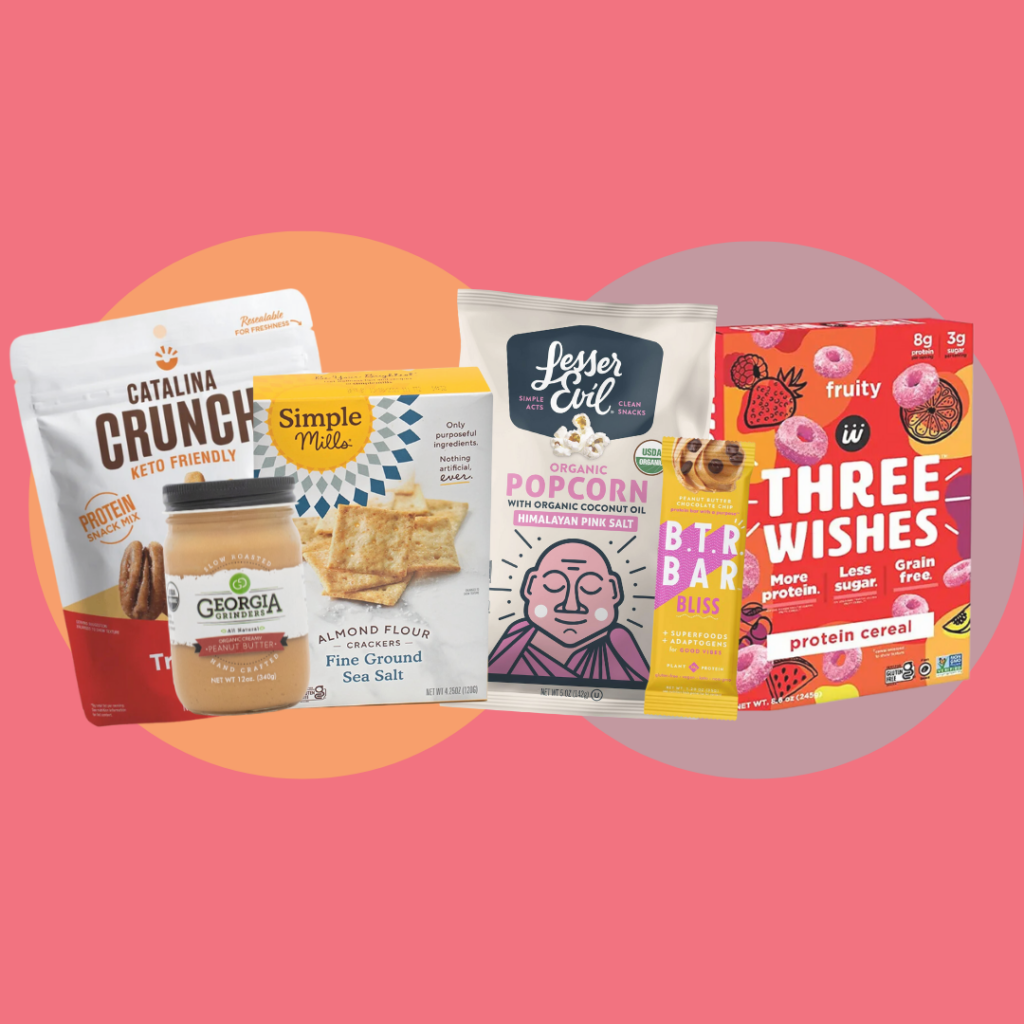
Can a person with diabetes eat crackers?
Always pair your crackers with a protein and/or fat, period. I’m a big fan of using them to transport tuna salad or dipping them in hummus for a savory snack option.
- Simple Mills Almond Flour Crackers: these were my savior during the first trimester, I literally munched on them all day long. They’re a higher fat and protein alternative to conventional sea salt crackers. They are made with simple, high quality ingredients.
- From The Ground Up Cauliflower Crackers: made from a base of veggies and cassava flour, these crackers have a high fiber content per serving.
- Real Phat Foods Almond Flour Crackers: with only 1g of carb per serving, these are the ultimate low-carb crunch factor. The whole food ingredients are all blood sugar friendly and are 100% gluten-free and dairy free.
Can a person with diabetes eat cookies?
- Simple Mills Almond Flour Cookies: these grain-free cookies made with a nut & seed flour blend make the perfect swap for your classic crunchy cookies. The 9g of fat per serving helps to balance out the 16g of carbs and won’t cause a sugar crash among consumption.
- Empowered Cookies (use code WN15 for 15% off): A low glycemic cookie that tastes good! Empowered cookies have a 3:2:1 fat, carbohydrate to protein ratio. They’re made with real food, blood sugar friendly ingredients that don’t cause a blood sugar crash; almond meal, flax seeds and coconut nectar. Plus they’re high in fiber.
- Catalina Crunch: with only 2g of sugar and 5g of net carbs, the Catalina Crunch sandwich cookies are an excellent option for diabetics. The cookies also contain pea protein which helps balance the effect of sugar.
Can a person with diabetes eat snack bars?
- Gratisfied Almond Butter Bars: No need for Nature Valley bars when you can have a Gratisfied bar instead! These baked grain-free, high protein bars are made with real food ingredients and are lightly sweetened with low-glycemic monk fruit.
- IQ Bar: high-fiber, low-sugar, these lunch-box friendly bars are great options for kids and adults. Each bar only has 3g of carbs and have added superfoods for brain health.
- Munk Pack Nut and Seed Bars: the Kind bar dupe that won’t leave your blood sugar absolutely wrecked! With less than 1g of sugar and 3g of carbs, the nut and seed bars are tasty options for when you’re craving something salty sweet.
What protein bars can I eat with diabetes?
This is a very important fact: a snack bar and a protein bar are two different things! A protein bar should contain protein, specifically, around 15-20g of protein. Meanwhile, a snack bar will likely be higher in fiber and fat, and meant primarily for a quick source of energy. Something to keep in mind when choosing both types of bars is if there are any added forms of sugars, including dried fruit and fruit juice. Low-glycemic sweeteners, such as monkfruit and stevia, are ok in moderation, but in excess can cause GI dysfunction. Pick a protein bar that is low in sugar, and is focused primary on the protein!
- B.T.R Nation: with 0g of added sugars and less than 15g of carbohydrates per bar, B.T.R bars are the perfect blood sugar friendly swap to your traditional high carb, high sugar protein bars.
- IQ Bar: I especially like IQ Bars for my patients with Type 1 or Type 2 diabetes as these bars were specifically designed for the diabetes population. They’re made with diabetes-friendly ingredients like nuts, seeds, and pea protein, and have only 2-3g of net carbs per bar. Use my code whitnessnutrition for 15% off!
- Resist Protein Bar: A single Resist bar contains 15g of protein and has a 1:4 ratio of protein to net carbohydrates. I love that these bars were designed by women, for women, to support blood-sugar balance and hormones. Learn more on how to pick a protein bar here and use WHIT15 for 15% off you 1st order.
Hot tip! If your protein bar has the protein content is higher than the net carbohydrates (total carb – total fiber), you’ve got a great bar!
Can a person with diabetes eat popcorn?
- Lesser Evil Popcorn: the addition of coconut oil adds healthy fats to balance out the carbohydrate content of popcorn. My personal favorite, the Oh-My-Ghee is made with ghee and is the perfect salty snack.
- Olive Oil and Sea Salt Popcorn: non-GMO and popped with olive oil, I like this option for those looking to reduce their consumption of seed oils. Plus, the 5g of fat and 4g of fiber will help balance blood sugar.
- SkinnyPop Sea Salt Popcorn: a go-to option to pair with nuts & dark chocolate for a balanced bliss mix. Do I love that it’s made with sunflower oil? No, but it’s a readily available option that I can find at most airports and gas stations, that I can balance out with something like jerky or nuts.
Can a person with diabetes eat peanut butter?
- Georgia Grinders Peanut Butter: my all time favorite peanut butter. They are 100% natural and just a superior quality. I take the resealable pouches with me when I travel for a quick & easy source of fat.
- Crazy Richard’s Peanut Butter: two ingredients, and that’s it. Their peanut butter is smooth, creamy and a great source of healthy fats.
- Spread the Love Peanut Butter: no palm oil, no added sugars, just creamy roasted peanut butter.
Can a person with diabetes eat dairy?
Dairy foods that someone with diabetes should be wary of include milk and yogurt, two options that are higher in lactose, which is the carbohydrate source. Milk and yogurt commonly contain more carbohydrates than fat and protein and should be paired with another food, such as nuts or seeds. But, the options below are naturally higher in protein and don’t require a balancing counterpart:
- Full Fat Cottage Cheese: cottage cheese is a great option as it has a great ratio of protein to carbs. It’s a healthy snack that you can pair with fruit for blood sugar balance.
- Plain Greek Yogurt: similar to cottage cheese, greek yogurt is an ideal snack for those with diabetes since it’s high protein, high fat. If you’re someone who tends to gravitate towards a nighttime snack, greek yogurt with nuts and frozen berries is a blood sugar friendly option that’s high protein & low sugar. Note! Plain greek yogurt is recommended, not flavored. Most flavored yogurts are high in sugar and would cause a spike in blood sugar.
- Grass-Fed Cheddar Cheese: grass-fed cheddar cheese is a low-glycemic cheese with only 1g of carbs per serving. Plus, with 9g of fat and 6g of protein per serving, the impact on one’s blood sugar would be quite small!
Can a person with diabetes eat cereal?
- Gratisifed: with 15g of healthy fats to balance out the 13g of carbs per serving, Gratisfied grain-free granola clusters a great swap for your typical granola. The granola is low-glycemic thanks to being lightly sweetened with coconut sugar rather than cane sugar.
- Three Wishes: made with just a few simple, low-glycemic ingredients, Three Wishes is an excellent cereal option for those with diabetes. Each serving has only 3g of sugar, and packs in 8g of protein. Pair with a low-carb milk alternative like almond or coconut for a blood sugar balanced pairing.
- Catalina Crunch: One of the best low carb cereals on the market! With 0g of sugar, 9g of fiber and 11g of protein per serving, you can munch on a serving of Catalina Crunch without worrying about blood sugar spikes.
Can a person with diabetes eat chips?
- Beanitos Black Bean Tortilla Chips: made from a base a black beans, these tortilla chips are a high fiber alternative to corn tortilla chips. One serving has 4g of fiber and 5g of protein.
- Wilde Protein Chips: I love these chips as a high protein snack. Made from chicken breast, bone broth and egg white, each serving has 10g of protein, and only 8g of carbs. Plus, there’s only 1g of sugar per serving!
- Siete Foods Grain Free Chips: high in fiber and healthy fats, the grain-free Siete tortilla chips are an excellent swap for corn-based chips. Pair with guac for the ideal balanced blood sugar pairing!
Can a person with diabetes eat desserts?
- Hu Chocolate Covered Nuts: chocolate covered nuts are a great way to balance the effect the sugar from the chocolate will have on blood sugar. Bonus, Hu doesn’t use any refined sugar or inflammatory oils in their products.
- Dalci Brownies: I’m obsessed with these brownies! They’re made with heart healthy, blood sugar balanced ingredients like avocado oil and almond flour, all of which are better baking alternatives for balanced blood sugar.
- B.T.R Nation Chocolate Truffles: no added sugar and sweetened with dates, these truffles are the perfect post-dinner treat. They’ve also got the added benefit of adaptogens and prebiotics!
What protein shakes are best for diabetes?
Glucerna and Ensure are not the best options for protein shakes when you have diabetes. In fact, they contain more sugar than many shakes on the market! They’re also made with cheap inflammatory oils, along with Splenda and sugar alcohols which can upset the stomach in large quantities. Try one of these options instead:
- Iconic – 20g of protein, 4g of carbs and 0g of added sugar. This option is made with grass-fed whey protein.
- Orgain – their plant based protein shake has 20g of protein and contains 0g of added sugars or artificial sweeteners.
- OWYN Elite – 0g of carbs per serving and packed with 32g of plant-based protein.
What is the best jerky for people with diabetes?
Always look for any added sugars in the ingredients list. Many name brand jerkys on the market sweeten their jerky with cane sugar or brown sugar, both of which are sure to spike blood sugar. Opt for a zero sugar or no sugar added option, the less ingredients the better here!
- The New Primal: With 0g of sugar and 7g of protein, TNP sticks are my favorite #purseprotein hands down. They’re also certified gluten-free, keto, paleo and Whole30 approved! Pair your Primal stick with cashews and an iced coffee for a quick & blood sugar balanced mid-afternoon snack!
- Chomps Sticks: 0g of sugar, 10g of protein, these meat sticks are great for on the go snacking. I pack these in my gym bag for a quick post-workout snack.
- Brooklyn Biltong: If you’re looking for a high protein snack but not as “chewy” as some jerkys are, try this! It’s softer then traditional jerky, but just as high in protein and low in carbs. The lemon pepper is my favorite!
- Prevail Jerky: If you’re looking for a slightly sweeter jerky, I recommend Prevail. They use low-glycemic coconut sugar to sweeten their jerky. Each serving packs in 12g of protein!
- Nicks Sticks: For those who prefer turkey over beef, Nicks free-range turkey sticks are my top recommendation. They have 0g of added sugar, 10g of protein and no msg, antibiotics or unnecessary junk!
- Country Archer Zero Sugar – The zero sugar beef jerky is one of my favorite beef-based jerky’s on the market. Keep an eye out and make sure you’re buying the Zero Sugar option with has 0g of sugar and 12g of protein. The Archer classic line does contain added sugars and is not as blood sugar friendly for those with diabetes!
Can a person with diabetes eat trail mix?
Instead of pre-packaged trail-mix, I typically recommend making a DIY trail mix. Include a mix of raw nuts, seeds and low-glycemic, high fiber additions. Avoid anything with sweetened or flavored nuts, an excessive amount of dried fruit and avoid anything candy-coated. Some simple pairings for a perfect blood sugar balanced trail mix could look like:
- Medjool Dates, Sunflower Seeds and Almonds
- Coconut Chips, Walnuts and Cashews
- Pumpkin Seeds, Pistachios and Dark Chocolate Chips
What yogurt is best for someone with diabetes?
- 2Good: If you’re someone who can’t get over the flavor of plain greek yogurt, 2Goods is one of the only flavored yogurts on the market I would recommend. They use stevia and a touch of fruit extract to lightly sweeten the yogurt. Each serving has around 2g of sugar and upward 12g of protein.
- Greek Yogurt: A plain greek yogurt option such as Stonyfields or Chobani are a protein-packed option for breakfast or a snack. Look for a plain option and steer clear of sweetened yogurts. Stick to no more than 5g of naturally occurring sugars per serving.
- Pillars Plant-Based Yogurt: a serving has only 1g of added sugar and 8g of plant-protein. Pillars is one of the very few dairy-free yogurts on the market that isn’t full of added sugars. Plus, it’s got protein and probiotics for optimal gut health!
What nut butter is best for diabetics?
- Almond Butter: Almond butter is a low-carb, high-protein, high-fat nut butter that’s also quite high in calcium. Pair with an apple or banana for a balanced snack!
- Sunflower Butter : sunflower seed butter is a great option for anyone with a nut allergy! Makes for a sweet, salty pairing with celery or snap peas.
- Walnut Butter: walnut butter is one of the lowest carb nut butters you can find. A serving of Artisana Naturals Walnut Butter has 7g of carb and 17g of fat.
What are the best dips for someone with diabetes?
- Guacamole: full of heart healthy fats that support brain health. Pair with one of the diabetes-friendly chips mentioned above or go for something fresh and crunchy like mini bell peppers or carrots.
- Hummus: with a low glycemic index of 6, hummus is a great addition to any snack. It’s got fat, fiber and even a bit of protein, which all contributes to a more stable blood sugar.
- Nut-Based Dips: dips made from a base of nuts, such as cashews or almonds, are a great swap for traditional dips made with added sugars. Make sure to read the label and pick the options made with just nuts, seasonings and either olive or avocado oil.
Can a person with diabetes eat dried vegetables?
When choosing dried vegetables, and dried fruits, look for ones without any added sugars or artificial ingredients. Opt for non-starchy veggies such as kale, seaweed or cauliflower. Pair any dried vegetables with a fat and/or protein to support blood sugar balance.
- Brad’s Kale Chips: 6g of carbs, 4gs of protein
- Rhythm Cauliflower Chips: 6g of carbs and 2g of fiber
- Gimme Seaweed Chips: 0g of carbs and high in iodine.
Can a person with diabetes eat frozen foods?
- Caulipower Chicken Nuggets: These nuggets have 40% less carbohydrates per serving compared to your average frozen chicken nuggets. Instead, they’re coated with a cauliflower and chickpea flour blend. Each serving has only 9g of carbs and 11g of protein.
- Veggies Made Great Egg Muffins: A great family friendly option with 1:1:1 protein, fat and carb ratio. They also have two keto flavors, Cinnamon and Chocolate, that are delicious and double as a sweet treat!
- OuterAisle Cauliflower Thins: These thins are a lower-carb alternative to toast and tortillas. They only have 2g of carbs and 4gs of protein. Unfortunately, they are not dairy-free, but are gluten and grain free!
Are you looking for more guidance around what to eat and why? Hop on the waitlist or continue to learn at your own pace with The Diabetes Master Class. Find my full list of favorite products here!

*Disclaimer: This blog post is not sponsored in any way but is meant to provide education. These are snacks that I personally enjoy and also recommend to patients with diabetes or other forms of blood sugar imbalance. However, I do work with some of these brands in the form of purposeful partnerships and some of the links in this post are affiliate links. I may get a small commission, but it doesn’t cost you anything extra, you’re just supporting me while I support you!
